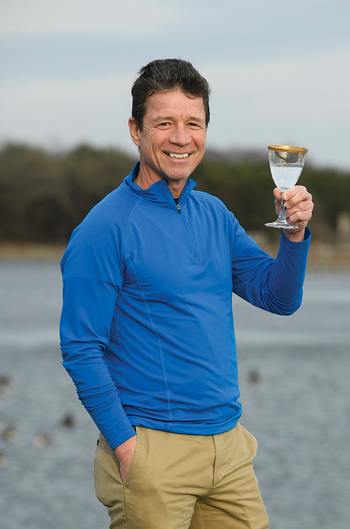Meet UD’s ‘water sommelier’

OUR FACULTY | Go ahead and pour yourself a glass of water. Now take a sip, and focus closely on the taste. Does it have a sharp metallic twang, or maybe a chemical wisp of chlorine? Can you sense any impurities, or even guess where the water originated?
Or, does it just taste like … water?
In the H20-saturated world of Prof. Gerry Kauffman, water is so much more than the world’s most ubiquitous calorie-free beverage and humanity’s most precious substance. To Kauffman, a single sip and a short sniff can reveal a bucketful of information—about the water itself, and also about its sometimes perilous journey from raindrop to river to tap.
As UD’s Delaware Water Resources Center director, his connoisseur’s nose for aquatic aesthetics has given him a reputation as UD’s “water sommelier”—a savant of sorts in the arcane science of assessing, protecting, collecting and purifying this life-sustaining substance. “I can taste the source and the odor,” he says. “It’s kind of a sixth sense, developed over time.”
His routine is such: Pour a glass of tap water, give it a swirl, check for cloudiness. Tipping his nose, he sniffs, then sips. A slightly wild note—like moss, or even algae—shows that nutrients from farms have leached into the creeks and rivers. A taste of hay, or wood chips (or even manure) means a mushroom farm, or maybe a dairy farm, lurks upstream.
The cast of contaminants goes on: Road salts. Magnesium and calcium. Bacteria and decaying plants.
In most cases these faint clues, while certainly off-putting, are fairly benign in terms of human consumption, he says. Yet through the UD-based center he leads, the state’s water managers rely on Kauffman and his interdisciplinary team to help give citizens the most pristine and palatable water possible.
Residents who blithely assume clean tap water is a given don’t realize the challenges that task still presents, or see the ongoing struggle being waged, especially in a society where each American uses 100 gallons a day. In Flint, Michigan, and many other cities, lead-contaminated water is an ongoing crisis, and in Delaware, 97 percent of the rivers and streams do not meet fish and wildlife water quality standards. Those same creeks and streams supply 75 percent of New Castle County’s drinking water.
So Kauffman and his team press for improvements in the prime sources of contamination, especially the Pennsylvania farmlands upstream from Delaware. “Water really is the foundation of our economy,” he says. “It contributes as much as $6 billion a year to the regional economy, through tourism, agriculture and industry, all of which rely on it.”
In his 20-plus years with the University, Kauffman has seen marked improvements in local waterways and gives the state a “B-minus” for its drinking water quality. Meanwhile, his search for that perfect sip continues.
“I have a Brita water filter,” he says with a smile. “It’s just that extra step to take out the taste and odor.”
Is my water Clean?
Some signs to look for when assessing the quality of your tap water. If you have any of these issues, or concerns about safety, reach out to your water supplier.
Cloudy Water/Sediment
Minerals are common and safe in drinking water, but they shouldn’t be visible to the naked eye.
Chlorine Odor
Chlorine is routinely added to purify water, but it should not smell like pool water (most easily detected while showering). High levels can cause stomach issues.
Orange or Brownish Tint
A sign of too much iron or manganese, sometimes caused by rusty pipes. Also indicated by rusty or tarnished silverware.
Oily Film
When oil and grease contaminate your water supply, you will notice it most easily in toilets and tubs.
Bitter or Metallic Taste
This could be a sign of pesticides, herbicides, medications and industrial chemicals.



